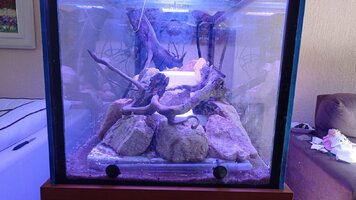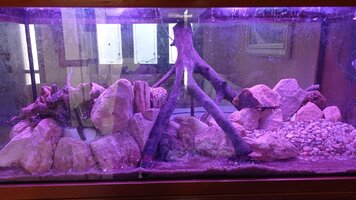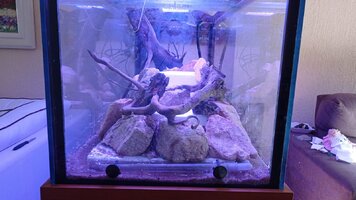For this last part of my initial block, some information on how things evolved from planting the tank up to today.
I decided back then to try having some massive water flow at the surface to try and ensure great levels of oxygenation. This would be an attempt at reducing the cycling time due to me having to rescue my plants, which were poorly stored in improvised containers during the initial blackout cycling period, and also the fauna, which was crammed together in a large bucket. Even worse, the filter was installed in the fish bucket, so no filter for the tank. With both wave makers positioned near the water surface and aimed slightly upwards, the surface turbulence was wild, and so was the general water movement all around. Realizing that this wouldn't be sustainable long-term if I wanted to have a high CO2 concentration, the plan was to eventually decrease the water flow.
At first, my main issue was keeping plants in place. Having used a lot of anubias, which were just pushed against the nooks between the stones, not glued, it became routine to find anubias swimming around and having to put them back in their place. The same happened with other plants, especially the ones at the top plateau. At some point, I just glued some of the more rebellious anubias and a crypto which for some reason also didn't liked staying where I wanted it to. I don't know if this strategy of high surface turbulence was/is beneficial, but this was the tank with the least amount of algae in my personal history.
Recently I set IOT timers for the wavemakers and have them alternating between one another, and 10 minutes every hour of absolute peace. The timers accept 30 inputs, so I made 15 daily on/off cycles, with hourly cycles during CO2 hours, and longer cycles at night. The fishes don't look bothered by the high flow and there are plenty of regions with gentle flow. But it is interesting to see them enjoy the 10 minutes of peace that they get. I assume it also helps build up some diluted CO2. Finally, having the wavemakers blowing water away from the wall side, where the surface skimmer is, I would get some accumulation of surface scum on the far end. With the pauses, I no longer notice that, I assume the scum gets skimmed during this window.
A second issue, likely due to this excessive water flow, is that my floating plants, which I'm using for the first time, after all the positive marketing I see for them in this forum, are not doing so well. While I don't see clear signs of nutrient deficiency, they end up taking some serious dives, which can't be good for them. Their movements alternate between circling along the surface, being all cramped together at some corner, or diving and acting like some sort of green K1 media. And worse, when they enter the diving mode, they get tangled with the anubias and sometimes just stay down there until I rescue them. This has decreased a bit since I started alternating the wavemakers, but it's not completely fixed yet. Their leaves are overall much smaller than they were originally, and so are their roots. Keeping new tissue culture plants rooted has been a challenge as well, but eventually the plants tire of swimming around.
At first, my plants at the plateau weren't doing so well. There were lots of deficiency signs, the Lilaeopsis all turned black, the Staurogyne looked like a bengal tiger with lots of stripes. By the way, I decided to put all kinds of "carpet" plants on the plateau and let the best plant win. One day, the anubias around the base of the plateau got suddenly covered in GSA, and with that I decided to turn off one of the two channels in the Chinese lamp on top of those plants. That channel had only red lights, so now half the tank is less red than the other half. Meh... Since this change, and after bumping the phosphate does from 3ppm to 4ppm weekly, I haven't noticed any serious GSA increase, but it didn't go away either. The new leaves are clean. The deficiency signs, on the other hand, subsided significantly. I'm now at the point where I can start trimming the Staurogyne, so some of the worse looking leaves are going away.
Right now I have the Staurogyne dominating the plateau and the Marsilias keeping their ground. The Monte Carlo spread all around forming sort of a net just above the substrate, but the leaves don't look great, they are small and don't close the gaps. I improvised a vase of Riccia fluitans up there as well and it did great, it looked really pretty. But it started getting out of control and shading everything else, so I recently moved it to another place, at substrate level. It doesn't pearl nearly as much, but it still looks healthy, and now there is more plateau room for the carpeting wars. A few weeks ago I added some Althernanthera minis up there and this week I tried P. helferi. They both came from tissue cultures and are having a hard time rooting in place, but the Althernanteras are better now. Some helferis went swimming and I kind of lost them... Hopeing that they show up at some point.
I'm really happy with my Nimphaea. In the previous setup, it grew huge dark purple leaves that took over significant volumes of the tank, shading everything around, until I eventually grounded it near a corner. This time, I wanted to keep it small and compact, growing from the side of the stone wall. I didn't know what would make it grow large or small, but I tried anyways and it has been great, it is exactly as I hoped. Maybe it was just a matter of explaining to the plant how I wanted it to grow. Maybe it was some bonsai effect with the roots restricted to a smaller space between the walls. Maybe it was the stronger light.
The balansae suffered the transition, but is now back stronger than before. In the previous setup, the leaves at the surface would get all kinds of algae, but now they are clean. I stuck some C. parvula between the anubias and they seem to be doing better than before as well.
On the stems side of the tank, the rotalas are looking good and I have to trim them every now and then. The blyxas used to be massive in the previous setup, but are now much more delicate. At first, they looked sad, but I think that when the new leaves sprouted, the old ones disappeared and now they all look bright green, albeit a bit small and sparse. Most of the stems that I put there either stunted or are not growing or died, but they weren't looking too good before moving them to the tank either. I want to try some different species, not really sure which ones. I wanted to try toninas, but I can't find them for sale. I had a large Ludwigia which kinda looked like a rose, but it was growing too fast and its leaves were too large, so eventually I removed it.
From the start, I had a moss at the top of the wood piece, right in the center of the tank, just under the glass brace, not directly under any of the lamps. I thought it would like it there, but it is looking very miserable. I have it growing great on a farming tank. I'm not sure what is wrong with it, but I'll give it some time to recover. I wonder if it suffers during water changes, since it is the first plant to be put outside of water and the last one to get immersed again. But I never notice it getting dry, it seems to hold humidity well. Pinnatiffidas, on the other hand, always died at my care and now are looking good and spreading all around. I always wanted to have them in my tanks and always failed for whatever reason, so one more good news. This week I bought some tissue cultured riccardia, split it in many parts and glued some of it all around the tank, in as many different micro-environments as I could. I'm curious to see which will grow better. I hope at least one of them pulls through.
Finally, the bolbitis used to be sad and miserable in the previous setup. Its leaves were darkened and opaque, small and brittle. It would grow ok under the shade of the main wood piece, but when it grew outside of it, it would get instantly filled with all kinds of algae. This time, I planted it under the same wood piece, but at the center, not directly under any light, and it's gotten huge and bright and glorious, even when reaching the direct light. It's getting a little too glorious, though, so I may need to consider putting some limits.
My few buces, which were being farmed far away from plant-eating fishes after the fiasco in the previous setup, suffered a bit during the transition, but are now looking a little better. A few of them had some GSA, but I have high hopes for them. The Althernanteras, on the other hand, have always suffered from curly leaves and stunting. Eventually one plant grows pretty, but when I trim it, it goes bad again. It has been this way since forever, and it didn't change in this setup. I read somewhere that it was better to discard the tops and let the base regrow, when trimming, but I have been doing that in most cases and it doesn't work for me. I'll try to replant the tops from now on and see what happens.
All things considered, on the plant side it has been a huge improvement over the previous setup, but there are still a few things to sort out. I'll now add a bunch of random photos that I dug out from my phone, somewhat in chronological order, but I'll make an effort of updating this journal with recent pictures as things evolve.
A few numbers to conclude this series of posts. Most off the top of my head, since I don't have my spreadsheets here with me.
Ferts are KNO3 (from a dubious source), potassium phosphate and magnesium sulfate 7H2O. Something like 10ppm NO3, 4ppm PO4 and whatever K comes from that, 0.5dGH of magnesium. This is the weekly dose, and I frontload half of that and divide the other half in 2 subsequent doses. I also frontload ~0.05ppm of Fe EDDHA (used to dose 0.1ppm, but it made the water too dark, now it is barely noticeable). I alternate with 3 days where I dose a mix of two local brands of micros. I mix them because I don't really trust either of them, so there's a better chance of having some micros in there this way. I don't have the numbers here, but I think I'm at maybe 2/3 of the dose in the instructions. Recently I tried to up it to 100% of the recommended dose, but I saw some stunting and some extra GSA and reverted back to what I had before.
Other than that, I frontload 2 tea spoons of magnesium sulfate and 2 of calcium chloride. Not calibrated tea spoons, actual spoons. At some point I weighted them, but now I don't remember what it was. But in the end, the GH rises from 3 (which is what I get from my tap water) to 6~7. I assume that the initial 3 are mostly calcium, so there is some extra Mg in the ferts solution.
On that note, I do weekly 50% water changes with tap water, filtered through activated coal. At some point, I was going crazy not knowing what was wrong, so I decided to switch from prime to activated coal, expecting that maybe my water was contaminated with herbicides or something. Nothing really changed, but now I'm gonna use the coal until I run out of it. My tap water is really soft, 0.5dKH and 3dGH. I have absolutely no other information, the water supplier only informs turbidity and some sort of microbial population metric, and I don't have many tests.
The 2 Finnex lamps ramp up from 0 to 100% from 9am to 12pm, then stay up there for 3 hours and ramp down to a low light setting from 3pm to 6pm, and then ramp down to zero from 6pm to 9pm. I don't remember exactly, but the indoor plant lamps turn on maybe at 11am and turn off at 5:30pm. The one on top of the stem plants has both channels on, and the one on top of the stone plateau has only one channel on.
CO2 runs from 8am to 6pm.
Did I miss anything?








